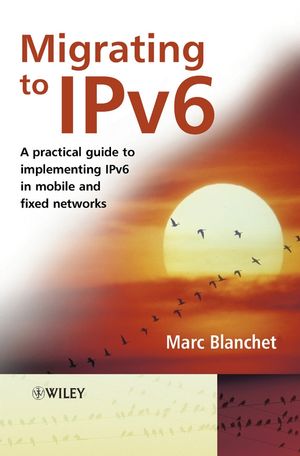Migrating to IPv6: A Practical Guide to Implementing IPv6 in Mobile and Fixed NetworksISBN: 978-0-471-49892-6
Hardcover
450 pages
January 2006
 This is a Print-on-Demand title. It will be printed specifically to fill your order. Please allow an additional 15-20 days delivery time. The book is not returnable.
|
||||||
Preface.
1 IPv6 Rationale and Features.
1.1 Internet Growth.
1.2 Real Issues and Trouble with IPv4.
1.3 Architectural Considerations.
1.4 Paradigm Shift.
1.5 IETF Work Towards IPv6.
1.6 IPv6 Main Features.
1.7 IPv6 Milestones.
1.8 IPv6 Return on Investment.
1.9 What Happened to IPv5?
1.10 Summary.
1.11 References.
2 I Can’t Wait to Get my Hands Dirty!
2.1 Setup Description.
2.2 Steps.
2.3 Summary.
2.4 References.
2.5 Further Reading.
3 IPv6 Datagram.
3.1 Description of the IP Datagram.
3.2 IPv4 Header.
3.3 IPv6 Header.
3.4 Header Fields.
3.5 Extension Headers.
3.6 Datagram Size.
3.7 Upper-layer Protocols.
3.8 Summary.
3.9 References.
4 Addressing.
4.1 Address Space.
4.2 Format of an Address.
4.3 Unicast Addresses.
4.4 Multicast Addressing.
4.5 Anycast.
4.6 Addressing Architecture.
4.7 Summary.
4.8 References.
4.9 Further Reading.
5 Configuring Node Addresses.
5.1 Static Address Configuration.
5.2 Address Auto-Configuration.
5.3 Lifetime of Advertised Prefixes.
5.4 Node Booting Process.
5.5 DHCPv6.
5.6 Node Addresses.
5.7 Configuring Interfaces and Router Advertisements on Hosts and Routers.
5.8 Summary.
5.9 Appendix.
5.10 References.
6 Link-layer Integration.
6.1 Solicited-Node Multicast Address.
6.2 Neighbor Solicitation and Advertisement.
6.3 Duplicate Address Detection.
6.4 Neighbor Cache.
6.5 EUI-64 and Neighbor Discovery.
6.6 IPv6 over Ethernet.
6.7 Point-to-Point Links.
6.8 Multi-link Subnets.
6.9 Router Advertisements of the Link MTU.
6.10 Managing Neighbors on Hosts and Routers.
6.11 Summary.
6.12 References.
6.13 Further Reading.
7 Internet Control Message Protocol.
7.1 ICMP.
7.2 Neighbor Discovery.
7.3 Hop Limit Set to 255.
7.4 Managing ICMP on Hosts and Routers.
7.5 Summary.
7.6 References.
8 Naming with DNS and Selecting an Address.
8.1 Hostname To IPv6 Address with the AAAA Record.
8.2 IPv6 Address To Hostname.
8.3 Transport.
8.4 DNS Server Discovery.
8.5 Node Information Query.
8.6 IP Address Selection.
8.7 Configuring DNS and Address Selection on Hosts and Routers.
8.8 Summary.
8.9 References.
8.10 Further Reading.
9 Routing.
9.1 Required Router Addresses.
9.2 Source Routing with the Routing Header.
9.3 Route Redirect.
9.4 Static Routes.
9.5 RIP.
9.6 OSPF.
9.7 IS-IS.
9.8 BGP.
9.9 Tunneling IPv6.
9.10 Renumbering Routers.
9.11 Internet Routing.
9.12 Multihoming.
9.13 Summary.
9.14 References.
10 Configuring Routing.
10.1 Considerations on Using Autoconfiguration for Router Interfaces.
10.2 FreeBSD.
10.3 Linux.
10.4 Solaris.
10.5 Windows.
10.6 Cisco.
10.7 Hexago.
10.8 Juniper.
10.9 Zebra.
10.10 Summary.
10.11 Further Reading.
11 Mobility.
11.1 Overview.
11.2 MobileIP.
11.3 Applications are not Aware of Mobility.
11.4 Mobile Node is at Home.
11.5 Mobile Node is away from Home.
11.6 Mobile Node is Moving Again.
11.7 Mobile Node Comes Back Home.
11.8 Securing the Binding Update.
11.9 Correspondent Node is Not MobileIP Aware.
11.10 Advanced Features.
11.11 MobileIP Messaging.
11.12 Deployment Considerations.
11.13 Configuring Mobility.
11.14 Summary.
11.15 References.
12 Wireless IP.
12.1 Characteristics of Wireless Links.
12.2 Header Compression over Limited Bandwidth Link Layers.
12.3 TCP Behavior over Wireless.
12.4 3GPP.
12.5 3GPP2.
12.6 Summary.
12.7 References.
12.8 Further Reading.
13 Security.
13.1 IP Security (IPsec).
13.2 Secure Shell (SSH).
13.3 Filtering and Firewalls.
13.4 Temporary Addresses.
13.5 More Secure Protocols.
13.6 Securing IPv6 on the Link.
13.7 Is IPv6 More Secure?
13.8 Configuring Security on Hosts and Routers.
13.9 Summary.
13.10 References.
14 Quality of Service.
14.1 IPv5: Streaming Protocol.
14.2 Diffserv.
14.3 Integrated Services.
14.4 Network Address Translation.
14.5 Hardware processing.
14.6 Configuring QoS on Hosts and Routers.
14.7 Summary.
14.8 References.
15 Multicast and Anycast.
15.1 Multicast Basics.
15.2 Multicast Listener Discovery.
15.3 Multicast Routing.
15.4 Multicast Address Allocation.
15.5 Unicast-based Multicast Addressing.
15.6 Allocation of Multicast Addresses.
15.7 Multicast Reserved Addresses.
15.8 Anycast.
15.9 Configuring Anycast and Multicast on Hosts and Routers.
15.10 Summary.
15.11 References.
16 Deploying IPv6 in IPv4 Dominant Networks.
16.1 Combined IPv4 and IPv6 Network.
16.2 Tunneling IPv6 in IPv4.
16.3 Tunneling IPv6 in GRE-IPv4.
16.4 Comparing IPv6 in IPv4 Solutions.
16.5 Configuring IPv6 in IPv4 Dominant Networks.
16.6 Summary.
16.7 References.
17 Deploying IPv6 Dominant Networks with IPv4 Support.
17.1 Tunneling IPv4 in IPv6.
17.2 IP Packet and Transport Translation.
17.3 Configuring IPv4 in IPv6 Dominant Networks.
17.4 Summary.
17.5 References.
18 Migrating with Application Level Gateways.
18.1 Application Level Gateway.
18.2 Application Specific Proxy.
18.3 Considerations of Application Level Gateways.
18.4 Summary.
19 Transport Protocols.
19.1 Checksum.
19.2 Transmission Control Protocol (TCP).
19.3 User Datagram Protocol (UDP).
19.4 Internet Control Message Protocol (ICMP).
19.5 Summary.
19.6 References.
20 Network Management.
20.1 SNMP Transport.
20.2 Management Information Base (MIB).
20.3 Other Management Tools.
20.4 Authentication, Authorization and Accounting using RADIUS.
20.5 Configuring SNMP on Hosts and Routers.
20.6 Summary.
20.7 References.
21 Porting Applications.
21.1 Introduction.
21.2 Considerations.
21.3 Structures.
21.4 Functions.
21.5 Change Table.
21.6 Best Practice.
21.7 Basic Example.
21.8 Summary.
21.9 References.
21.10 Further Reading.
22 Configuration and Usage of IPv6-enabled Open Source Software.
22.1 Apache Web Server.
22.2 Sendmail.
22.3 Postfix.
22.4 SSH.
22.5 XFree86.
22.6 MRTG.
22.7 Dovecot.
22.8 Summary.
22.9 References.
23 Best Current Practices and Case Studies.
23.1 IPv6 Internet Address Space.
23.2 IPv6 Address Policy.
23.3 IPv6 Address Planning.
23.4 Incremental Deployment.
23.5 DNS Considerations.
23.6 Routing Considerations.
23.7 Security Considerations.
23.8 Mail Considerations.
23.9 Deploying IPv6 and Connecting to the IPv6 Internet.
23.10 Summary.
23.11 References.
23.12 Further Reading.
24 Conclusion.
25 Quick Reference.
Index.



